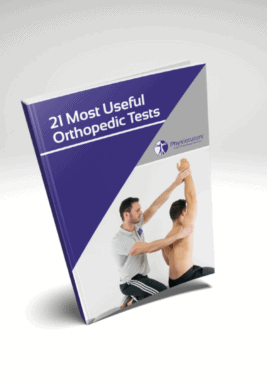Learn
Vestibulocochlear Nerve | Cranial Nerve VIII / CN VIII Assessment
The vestibulocochlear nerve (CN VIII) is a specialized sensory nerve for hearing and balance. Auditory screening is commonly done with the Rinne test and Weber test.
A systematic review by Kelly et al. (2018) revealed diagnostic accuracy data for both of the tests. The Rinne test had a reported sensitivity ranging from 16 to 91% and specificity between 50 to 100%. For Weber’s test, the authors report a sensitivity ranging from 18 to 67% and a specificity between 33 to 97%. The studies included were too heterogenous in the technique they used to allow for pooling of results so the clinical value is at least moderate.
Auditory Assessment
To quickly assess the auditory component, a simple test is done with the patient in sitting position. Cover one of the patient’s ears at a time. At around 60cm distance of the open ear whisper a couple of numbers at the end of exhalation and ask the patient to repeat them.
Repeat the procedure with the other ear. In case you observe deficits Rinne’s Test and Weber’s test are performed.
Rinne’s Test
For Rinne’s test, the patient is in sitting position. Preferably use a 256 or 512 Hz tuning fork.
Strike the tuning fork and place it on the patient’s mastoid process. Ask the patient to indicate once they no longer hear the buzzing sound. The fork is then immediately moved in front of the patient’s external auditory meatus to assess whether they can still hear the sound. Normally, air conduction of sound in the second step should be greater than bone conduction in the first one. So the sound should be audible in the second step even when it had subsided in the first step.
Weber’s Test
For Weber’s test, place the tuning fork in the middle of the patient’s forehead and ask them whether they hear it louder in one ear or in the middle.
Vestibular Assessment
A quick assessment of the vestibular system could be to observe the patient’s eyes for a nystagmus after they maximally turn their head to one side. More sophisticated tests include the Dix- Hallpike maneuver, which is a popular test in BPPV.
21 OF THE MOST USEFUL ORTHOPAEDIC TESTS IN CLINICAL PRACTICE

Learn more about the assessment of all cranial nerves below:
- Cranial Nerve I: Olfactory Nerve
- Cranial Nerve II: Optic Nerve
- Cranial Nerve III: Oculomotor Nerve
- Cranial Nerve IV: Trochlear Nerve
- Cranial Nerve V: Trigeminal Nerve
- Cranial Nerve VI: Abducens Nerve
- Cranial Nerve VII: Facial Nerve
- Cranial Nerve IX: Glossopharyngeal Nerve
- Cranial Nerve X: Vagus Nerve
- Cranial Nerve XI: Accessory Nerve
- Cranial Nerve XII: Hypoglossal Nerve
References
Like what you’re learning?
BUY THE FULL PHYSIOTUTORS ASSESSMENT BOOK
- 600+ Pages e-Book
- Interactive Content (Direct Video Demonstration, PubMed articles)
- Statistical Values for all Special Tests from the latest research
- Available in 🇬🇧 🇩🇪 🇫🇷 🇪🇸 🇮🇹 🇵🇹 🇹🇷
- And much more!








